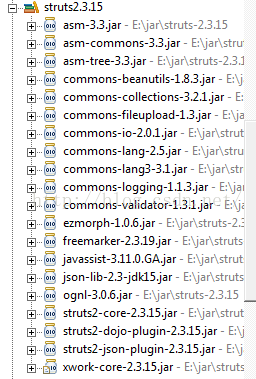Struts2 搭建一个简单登录应用
一、为何用Struts2框架
(1)实现MVC模式,结构清晰
(2)丰富的标签(tag)
(3)通过配置文件页面导航,便于后期维护
(4)与Servlet API松耦合,便于测试
二 、到官网下载: http://struts.apache.org
三、目前我使用的是struts-2.3.15
四、开发的具体步骤如下:
1、创建工程,引入Struts 2工程所需运行库文件。
2、创建并配置web.xml文件
在web.xml中配置FilterDispatcher
<?xml version="1.0" encoding="UTF-8"?>
<web-app version="3.0"
xmlns="http://java.sun.com/xml/ns/javaee"
xmlns:xsi="http://www.w3.org/2001/XMLSchema-instance"
xsi:schemaLocation="http://java.sun.com/xml/ns/javaee
http://java.sun.com/xml/ns/javaee/web-app_3_0.xsd">
<display-name></display-name>
<welcome-file-list>
<welcome-file>index.jsp</welcome-file>
</welcome-file-list>
<filter>
<filter-name>struts2</filter-name>
<filter-class>
org.apache.struts2.dispatcher.ng.filter.StrutsPrepareAndExecuteFilter
</filter-class>
</filter>
<filter-mapping>
<filter-name>struts2</filter-name>
<url-pattern>/*</url-pattern>
</filter-mapping></web-app>
Struts2的核心控制器FilterDispatcher被设计成了过滤器,通过<filter></filter>标签引</span>
<url-pattern>/*</url-pattern>说明所有客户端请求都经由FilterDispatcher处理,并把过滤后的请求交给Struts2进行处理。
3、创建一个Action类
编写Action
- Struts2直接使用Action来封装HTTP请求参数,因此Action类应该包含与请求相对应的属性,并为该属性提供对应的setter和getter方法。
- 为Action类里增加一个execute方法,因为Struts2框架默认会执行这个方法。这个方法本身并不做业务逻辑处理,而是调用其他业务逻辑组件完成这部分工作。
- Action类返回一个标准的字符串,该字符串是一个逻辑视图名,该视图名对应实际的物理视图。
package com.hlx.action.login;
import com.hlx.dao.LoginDao;
import com.opensymphony.xwork2.ActionSupport;
public class LoginAction extends ActionSupport {
// 对应表单属性 封装(setXXX and getXXX)
private String uname;
private String upass;
public String getUname() {
return uname;
}
public void setUname(String uname) {
this.uname = uname;
}
public String getUpass() {
return upass;
}
public void setUpass(String upass) {
this.upass = upass;
}
@Override
public String execute() throws Exception {
// System.out.println(10/0); //运行发生的异常
// 调用业务方法
if (LoginDao.isLogin(uname, upass)) {
return SUCCESS;
} else if ("".equals(uname) && "".equals(upass)) {
return ERROR;
}else {
return INPUT;
}
}
}
Action有一下特点:
- Struts2框架中Action是一个POJO,没有被代码污染。
- Struts2中的Action的execute方法不依赖于servlet API,改善了Struts1中耦合过于紧密,极大方便了单元测试。
- Struts2的Action无须用ActionForm封装请求参数。
- 相对Struts1框架而言,Struts2的逻辑视图不再是ActionForward对象,而是一个普通的字符串,利于分离和复用。
4、创建并配置struts.xml文件。
配置struts.xml
Struts2框架的核心配置文件就是struts.xml,该文件主要负责Struts2应用中各Action的具体实现逻辑。struts.xml会根据不同请求找到具体的Action,然后根据Action返回的逻辑视图名找到具体的物理视图。
<?xml version="1.0" encoding="UTF-8" ?> <!DOCTYPE struts PUBLIC "-//Apache Software Foundation//DTD Struts Configuration 2.1//EN" "http://struts.apache.org/dtds/struts-2.1.dtd"> <struts> <package name="hlx" namespace="/" extends="struts-default"> <!-- 全局结果 --> <global-results> <result name="error">/err.jsp</result> <result name="er_1">/error.jsp</result> </global-results> <!-- 异常映射 --> <global-exception-mappings> <exception-mapping result="er_1" exception="java.lang.RuntimeException"/> </global-exception-mappings> <action name="login1" class="com.hlx.action.login.LoginAction"> <result type="redirect">/index.jsp</result> <result name="input">/login.jsp</result> </action> </package> </struts>
编写视图资源
1、登陆页面login.jsp
<h1> 登录 [属性方式]</h1> <form method="post" action="login1" name="frm"> <p> 用户名:<input type="text" name="uname"> </p> <p> 密 码:<input type="password" name="upass"> </p> <p> <input type="submit" value="登录" name="button1"> </p> </form>
2、登陆成功页面success.jsp
<%@ page language="java" import="java.util.*" pageEncoding="UTF-8"%>
<%@ taglib prefix="s" uri="/struts-tags"%>
<%
String path = request.getContextPath();
String basePath = request.getScheme()+"://"+request.getServerName()+":"+request.getServerPort()+path+"/";
%>
<!DOCTYPE HTML PUBLIC "-//W3C//DTD HTML 4.01 Transitional//EN">
<html>
<head>
<base href="<%=basePath%>">
<title>My JSP 'index.jsp' starting page</title>
<meta http-equiv="pragma" content="no-cache">
<meta http-equiv="cache-control" content="no-cache">
<meta http-equiv="expires" content="0">
<meta http-equiv="keywords" content="keyword1,keyword2,keyword3">
<meta http-equiv="description" content="This is my page">
<!--
<link rel="stylesheet" type="text/css" href="styles.css">
-->
</head>
<body>
<h1>欢迎使用Struts2 </h1><br>
<s:property value="uname"/> :<s:property value="upass"/><p/>
</body>
</html>
3、登陆失败页面err.jsp
<%@ page language="java" import="java.util.*" pageEncoding="UTF-8"%>
<%
String path = request.getContextPath();
String basePath = request.getScheme()+"://"+request.getServerName()+":"+request.getServerPort()+path+"/";
%>
<!DOCTYPE HTML PUBLIC "-//W3C//DTD HTML 4.01 Transitional//EN">
<html>
<head>
<base href="<%=basePath%>">
<title>My JSP 'err.jsp' starting page</title>
<meta http-equiv="pragma" content="no-cache">
<meta http-equiv="cache-control" content="no-cache">
<meta http-equiv="expires" content="0">
<meta http-equiv="keywords" content="keyword1,keyword2,keyword3">
<meta http-equiv="description" content="This is my page">
<!--
<link rel="stylesheet" type="text/css" href="styles.css">
-->
</head>
<body>
错误页面。。。。。。。。。。。。. <br>
</body>
</html>
